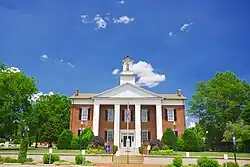Columbus, North Carolina
Columbus is a town in Polk County, North Carolina, United States. The population was 999 at the 2010 census. It is the county seat of Polk County.[4]
Columbus, North Carolina | |
|---|---|
 | |
 Flag  Seal | |
 Location of Columbus, North Carolina | |
| Coordinates: 35°14′57″N 82°12′04″W | |
| Country | United States |
| State | North Carolina |
| County | Polk |
| Area | |
| • Total | 3.77 sq mi (9.76 km2) |
| • Land | 3.76 sq mi (9.73 km2) |
| • Water | 0.01 sq mi (0.03 km2) |
| Elevation | 1,148 ft (350 m) |
| Population (2020) | |
| • Total | 1,060 |
| • Density | 282.14/sq mi (108.94/km2) |
| Time zone | UTC-5 (Eastern (EST)) |
| • Summer (DST) | UTC-4 (EDT) |
| ZIP code | 28722 |
| Area code | 828 |
| FIPS code | 37-13980[3] |
| GNIS feature ID | 2406301[2] |
| Website | www.columbusnc.com |
History
The Green River Plantation, J. G. Hughes House, and Polk County Courthouse are listed on the National Register of Historic Places.[5]
Geography
The town is concentrated along North Carolina Highway 108, southeast of Asheville, and a few miles north of the North Carolina-South Carolina border. U.S. Route 74 passes through the northern part of town, and Interstate 26 passes through the eastern section.
According to the United States Census Bureau, the town has a total area of 1.8 square miles (4.7 km2), all land.
Demographics
| Census | Pop. | Note | %± |
|---|---|---|---|
| 1880 | 71 | — | |
| 1900 | 334 | — | |
| 1910 | 122 | −63.5% | |
| 1920 | 168 | 37.7% | |
| 1930 | 340 | 102.4% | |
| 1940 | 390 | 14.7% | |
| 1950 | 486 | 24.6% | |
| 1960 | 725 | 49.2% | |
| 1970 | 731 | 0.8% | |
| 1980 | 727 | −0.5% | |
| 1990 | 812 | 11.7% | |
| 2000 | 992 | 22.2% | |
| 2010 | 999 | 0.7% | |
| 2020 | 1,060 | 6.1% | |
| U.S. Decennial Census[6] | |||
2020 census
| Race | Number | Percentage |
|---|---|---|
| White (non-Hispanic) | 842 | 79.43% |
| Black or African American (non-Hispanic) | 20 | 1.89% |
| Native American | 4 | 0.38% |
| Asian | 3 | 0.28% |
| Pacific Islander | 1 | 0.09% |
| Other/Mixed | 59 | 5.57% |
| Hispanic or Latino | 131 | 12.36% |
As of the 2020 United States census, there were 1,060 people, 491 households, and 292 families residing in the town.
2000 census
As of the census[3] of 2000, there were 992 people, 414 households, and 238 families residing in the town. The population density was 559.1 inhabitants per square mile (215.9/km2). There were 442 housing units at an average density of 249.1 per square mile (96.2/km2). The racial makeup of the town was 90.32% White, 5.95% African American, 0.20% Native American, 3.12% from other races, and 0.40% from two or more races. Hispanic or Latino of any race were 7.56% of the population.
There were 414 households, out of which 19.8% had children under the age of 18 living with them, 44.7% were married couples living together, 10.4% had a female householder with no husband present, and 42.5% were non-families. 38.6% of all households were made up of individuals, and 26.8% had someone living alone who was 65 years of age or older. The average household size was 2.08 and the average family size was 2.75.
The population was spread out, with 17.5% under the age of 18, 5.0% from 18 to 24, 21.1% from 25 to 44, 17.6% from 45 to 64, and 38.7% who were 65 years of age or older. The median age was 52 years. For every 100 females, there were 86.1 males. For every 100 females age 18 and over, there were 79.4 males.
The median income for a household was $25,469, and the median income for a family was $38,542. Males had a median income of $30,000 versus $19,000 for females. The per capita income for the town was $15,587. About 9.3% of families and 15.8% of the population were below the poverty line, including 18.7% of those under age 18 and 13.8% of those age 65 or over.
References
- "ArcGIS REST Services Directory". United States Census Bureau. Retrieved September 20, 2022.
- U.S. Geological Survey Geographic Names Information System: Columbus, North Carolina
- "U.S. Census website". United States Census Bureau. Retrieved January 31, 2008.
- "Find a County". National Association of Counties. Archived from the original on May 31, 2011. Retrieved June 7, 2011.
- "National Register Information System". National Register of Historic Places. National Park Service. July 9, 2010.
- "Census of Population and Housing". Census.gov. Retrieved June 4, 2015.
- "Explore Census Data". data.census.gov. Retrieved December 19, 2021.
External links
 Media related to Columbus, North Carolina at Wikimedia Commons
Media related to Columbus, North Carolina at Wikimedia Commons- Official website
